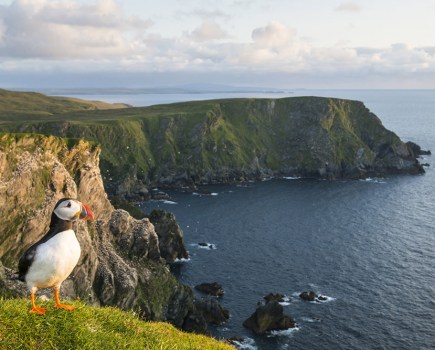Wildlife photography has the ability to grab attention by showing the natural world in action. Whether you’re looking to capture images of unusual and exotic animals, or show off the best of your local countryside, there’s a whole host of wildlife photography tips and techniques that can take your images to another level and help you see nature with new eyes.
How to get into wildlife photography
The very first step is to hone your skills. Learn everything you can and get outside and practice, practice, practice. Below, you’ll find the best wildlife photography tips and techniques from professionals, experiment with these and you’ll see your images improve. Then, start to build up a portfolio of your best images and try submitting your photographs to photography competitions as well as local newspapers and magazines.
Wildlife photography tips and techniques from Luke Massey
Wildlife photography; it sounds so glamorous. Witnessing amazing sights, going to incredible places and spending hours watching stunning creatures going about their business while doing your best to get a photograph that does the encounter justice.
It is, in my opinion, one of the best careers or hobbies anyone could choose. What could be better than exploring the wilds (both rural and urban) in search of nature? I read a wonderful quote recently: ‘You should sit in nature for 20 minutes a day – unless you’re busy, then you should sit for an hour.’
Within the UK and further afield there are countless opportunities and now is as good a time as any to start. Equipment has become more affordable; you can start with anything from bridge cameras to DSLR set-ups. You can specialise, too – not everything needs to be shot with a bazooka-like telephoto, so why not go for something a bit different by shooting wildlife with a wideangle or get up close and personal with macro lenses?
Wildlife photography isn’t easy. Yes, sometimes opportunities will be put right in front of you, but at other times you’ll need hours of patience for that one moment. Ethics are key, from how you approach and treat your subject to how you tell the story behind your photo, allowing full disclosure. A lot is down to your own judgement.
Over the course of this feature, I hope I’ll be able to give you some helpful hints, advice and guidance on ways in which you can improve your wildlife photography.
Tip 1 – Start a wildlife photography project
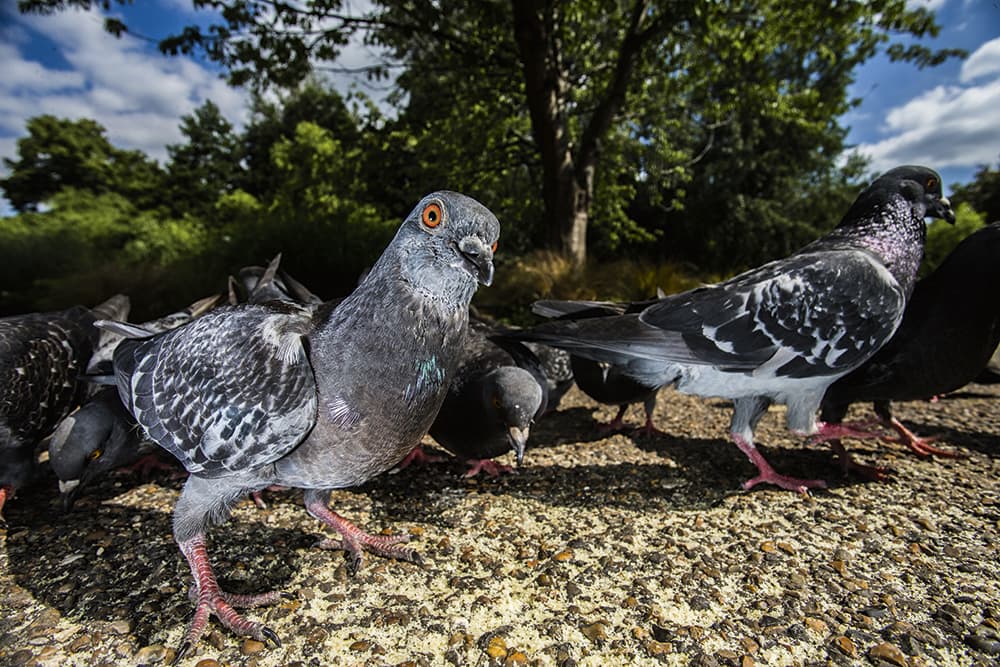
Pigeons – the ultimate starter project! Canon EOS-1D X, Canon 17-40mm at 40mm, 1/250sec @ f/16, ISO 100, external flash
The best way of improving your wildlife photography and learning about a subject? Start a project. They’re easy to do and can be a lot of fun; plus if you’re trying to make a career out of wildlife photography, a well put together project can often be the perfect way of getting noticed.
From your local fox family to feral pigeons and everything in between, they all exhibit interesting behaviour and live in photogenic environments. It doesn’t have to be one animal – perhaps tell the story of your local park or farm. Projects can also be used to tell important conservation stories.
If you’re starting out in wildlife photography, choose a common or easy-to-photograph species such as pigeons. Then you’ll be able to keep going back to improve your technique. You’ll hopefully be able to repeat instances and behaviour but you never know, you might record something never seen before!
Tip 2 – Light

Sunrise and sunset provide fantastic lighting conditions. Canon EOS-1D Mark IV, Canon 500mm, 1/2500sec @ f/4, ISO 160
Light is key. Backlighting and rim light are fantastic for wildlife photography, especially in winter when the sun is low, not high and harsh as it is during summer. The warmer the light the better.
Remember that the shape of your animal is key – a hunched-over pigeon, for example, may not make the best backlight subject. Light can also be used to create silhouettes, especially when the sun has gone down.
Tip 3 – Framing
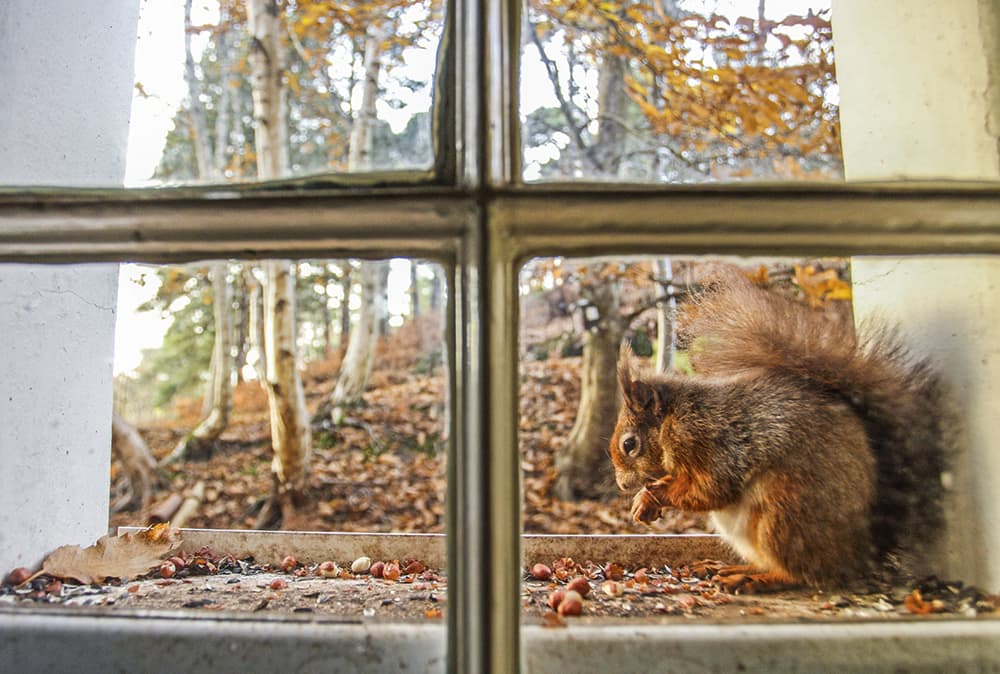
Framing can make the difference between a good photo and a great one. I’ve seen images (including mine) that would be improved if the taker was a foot to the left or right. Be patient – either move into a better position to frame your subject or wait for it to move into a better location that will allow for a more striking image.
Time and again I see images from people (myself included) where if they were a foot to the left or right the whole image would be improved.
Tip 4 – Timing
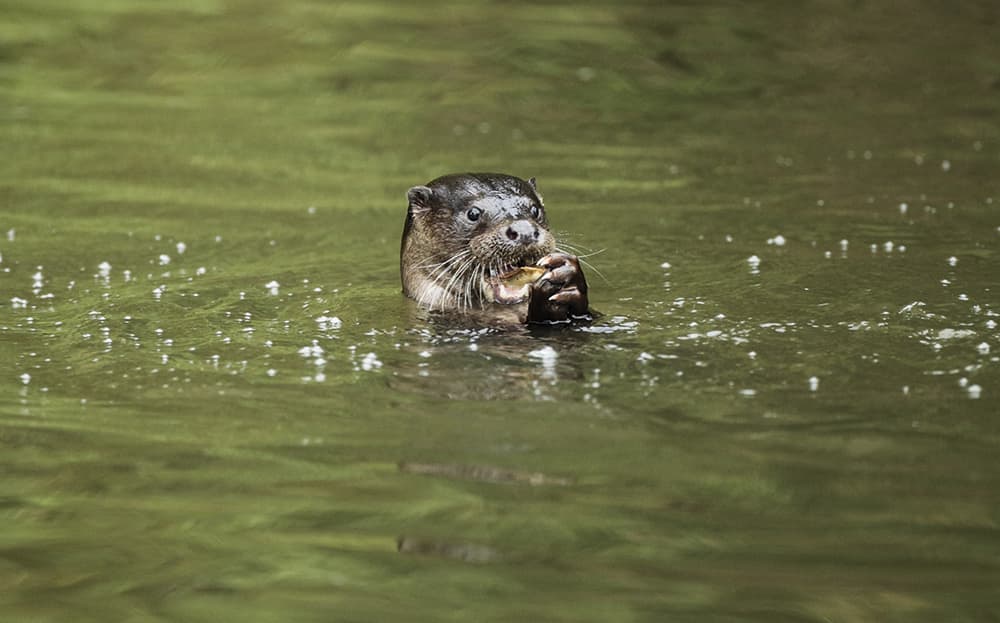
Otters can be tricky to track down; dawn and dusk are your best bets. Canon EOS-1D Mark IV, Canon 500mm, 1/250sec @ f/4, ISO 1250
Timing is important for wildlife photography in more ways than one. Early morning and evenings are not only best for light, but animals are often most active then. Otters, for example, are often seen at dawn.
Timing can relate to your approach, too. During breeding seasons in spring, don’t get too close to nests or dens. The subject’s welfare should always come first. Time of year can be key, too, such as in winter when large flocks of wintering wildfowl can be found.
Tip 5 – Backgrounds
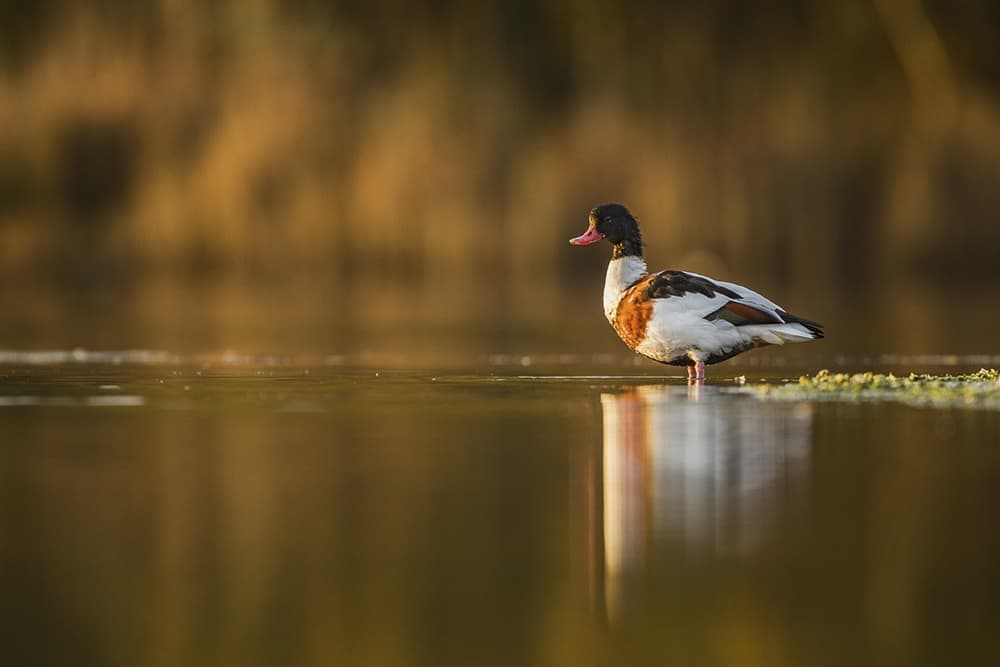
Check your background – if it’s distracting it can ruin the image. Canon EOS-1D Mark IV, Canon 500mm, 1/250sec @ f/4, ISO 400
Backgrounds for me can make or break an image. Sometimes you don’t have a choice and the subject is in front of the messiest background possible or it just blends in too much (although that can tell a story). Before shooting, see if there’s an alternative. Maybe you can lose the background by changing your exposure to throw it into darkness or throw it out of focus by changing your aperture and reducing your depth of field.
Tip 6 – Go wide

Close-up portraits may be stunning, but zooming out and getting the whole scene including your subject can be just as effective. Or the complete opposite, maybe you can get close-up or use a camera trap. Using a wideangle on an animal close up can give some fantastic wildlife photography results. It could show them in a different perspective, give a sense of scale and show what kind of environment they live in.
Tip 7 – Experiment

Low light? Pan! Canon EOS-1D X, Canon 500mm, 1/25sec @ f/4, ISO 200
Do not be afraid to experiment. Play around with your settings and see what you get – although some would argue there’s a fine line between artistic blur and ready for your reject pile. If your subject is hanging around but moving, you can knock your shutter speed down and go for some pans; if the light is low, that will lend itself to some panning action, too. Whatever you do, please don’t do the classic zoom in/out on bluebells.
Tip 8 – Be true to yourself and your subject
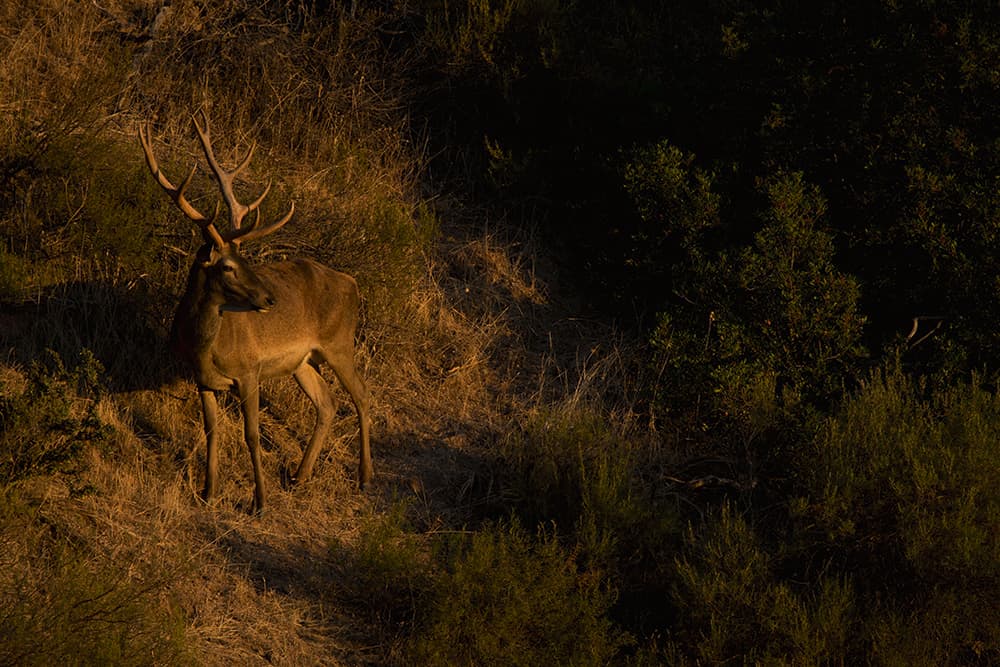
Let nature be and keep your images as natural as possible. Canon EOS-1D X, Canon 500mm with 1.4x converter, 1/800sec @ f/5.6, ISO 500
Wildlife is wild. That doesn’t mean you can’t take photos of captive animals, just don’t forget to let people know that that is what they are. Your photos should be near identical to the scene you saw through the viewfinder, though of course there’s no harm in making a few changes to brightness, contrast and the like, in Lightroom or Photoshop. Don’t add elements to an image and not say so. Likewise don’t remove elements that were there. There may be an annoying branch in the background but try to frame it out as you take the shot, not in post.
Baiting is all down to personal preference, but I’m morally against live baiting. Carrion, seeds, peanut butter etc are all useful and often make secretive animals a little easier to photograph. If baiting is used, do so sparingly; never let an animal become reliant on your food supply. Always remember what kind of photo you’re taking. You want to represent behaviour that is typical of that animal.
Tip 9 – Holiday
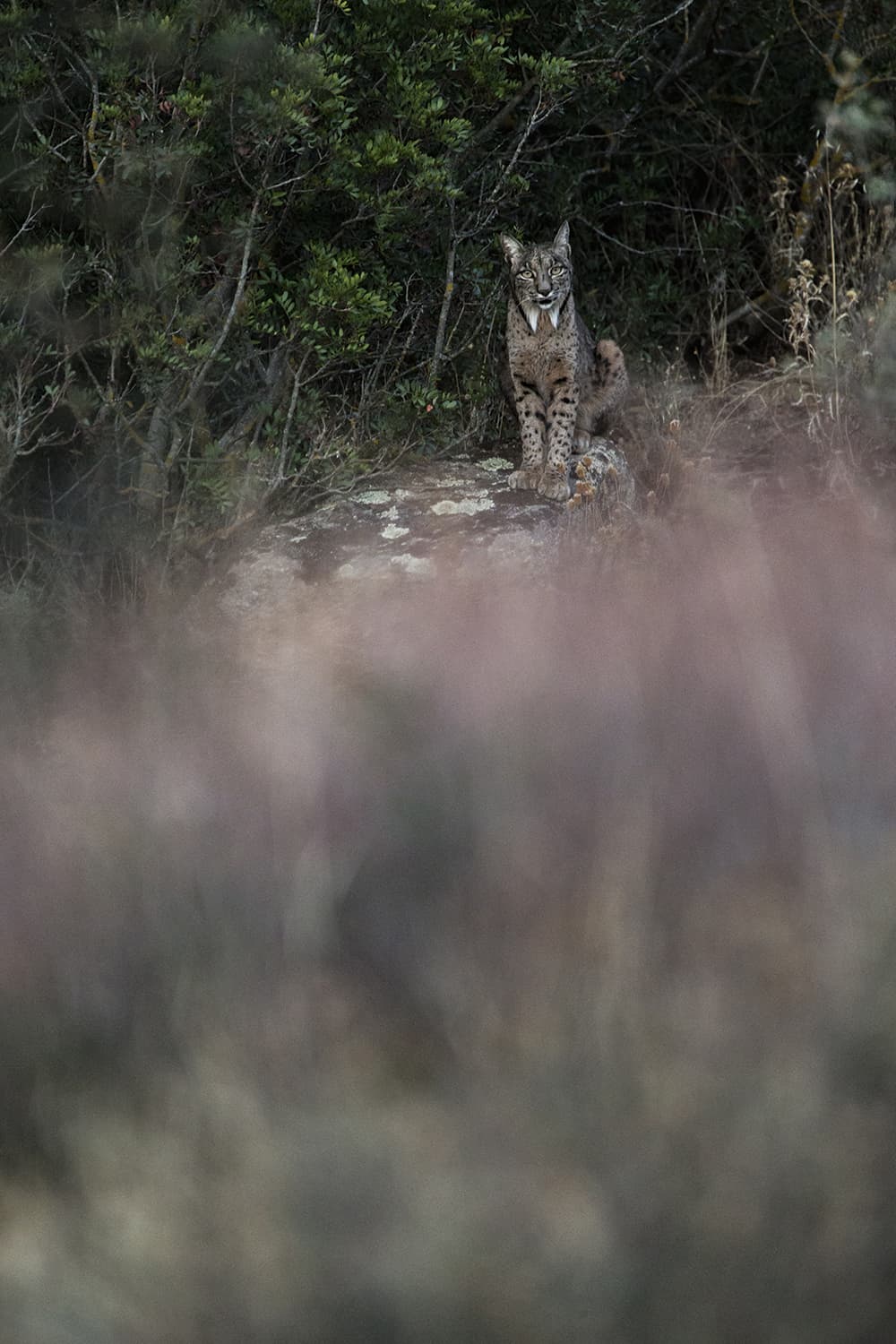
Turn your holiday into a photographic adventure. Canon EOS-1D X, Canon 500mm with 1.4x converter, 1/320sec @ f/5.6, ISO 3200
What better way of exploring your wildlife photography passion than by taking it on holiday with you? Countries all over the world – from Finland to Ecuador, Spain to Australia – are offering wildlife holidays. Be it specialist hides or safaris, photographing nature has become a lot more accessible.
Britain has some fantastic species, but you might get something a little different abroad. You don’t have to go far; take a short-haul flight to southern Spain and you could be photographing imperial eagles or even the rarest cat in the world, the Iberian lynx.
Africa is, of course, famous for its safaris. Try not to go with a tick list. Try to simply enjoy everything you see – don’t go chasing after the big five. Instead spend time with species. Baboons are common but if you spend an hour or two with them then you’ll see some amazing behaviour and possibly come home from your trip with a photo someone hasn’t got before on safari.
Tip 10 – Urban jungle
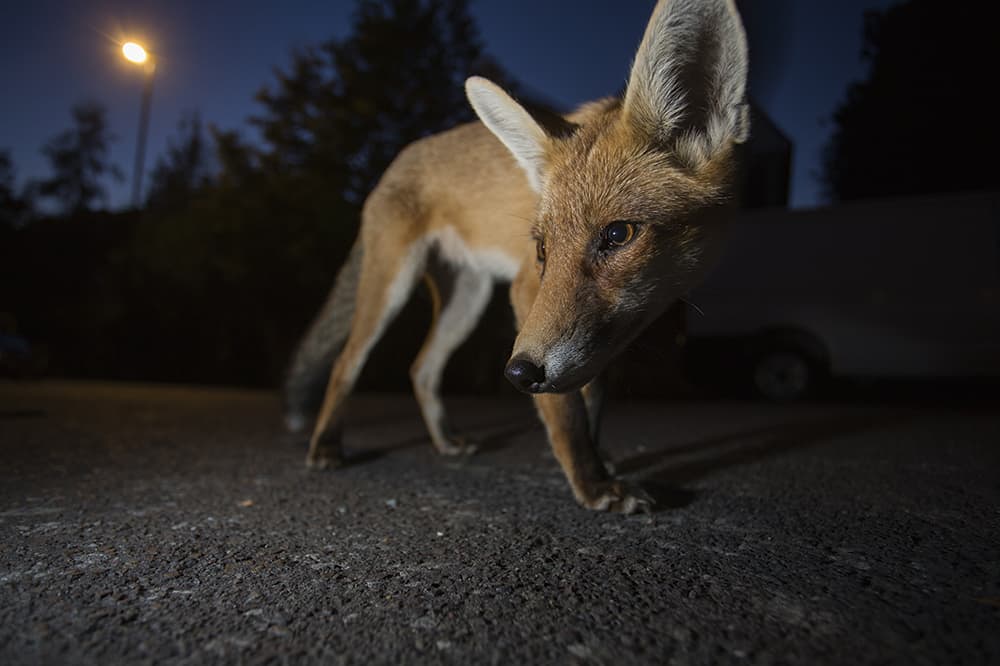
Nature is everywhere, even in our cities. Canon EOS-1D X, Canon 17-40mm at 40mm, 1/8sec @ f/4, ISO 125, external flash. Photography by Luke Massey
Wildlife doesn’t exist only in rural surrounds; many species are quite at home in our cities, too. Don’t think because you’re stuck in a city that there won’t be any animals. Of course, urban foxes are well known, but look out also for badgers, deer and even otters. Many bird species live in our towns and cities as well – our buildings can give good nesting sites away from predators.
Tip 11 – Weather
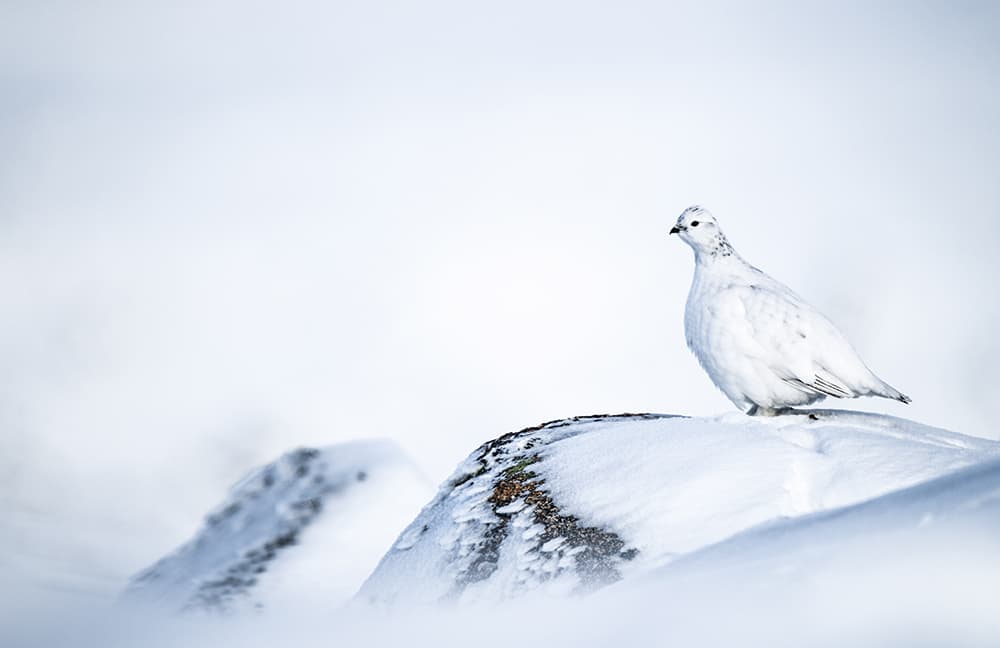
Even poor weather can provide exciting photographic opportunities. Canon EOS-1D Mark IV, Canon 500mm, 1/320sec @ f4, ISO 50
Check the forecast. Some animals won’t come out in bad weather, such as owls in heavy rain. Check rainfall timings – if it has been raining all day in summer and stops an hour or so before sunset, animals will be coming out to forage. Weather also offers wildlife photography opportunities. Fast shutter speeds in heavy rain give great frozen droplets, while misty mornings can provide incredibly atmospheric photo opportunities.
Tip 12 – Storytelling
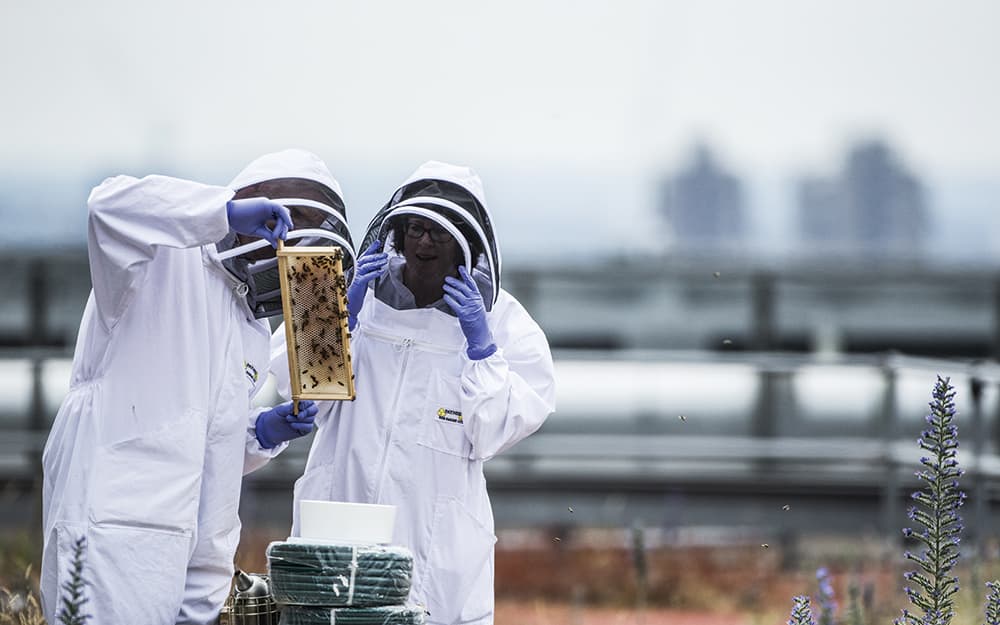
Images are the perfect tool for storytelling, as people often connect more with imagery than words. Some animals help you with expressions or body language. But the stories don’t just have to be good ones – images are great for educating. A photo of an injured or dead animal can tell a story equally as well as a live one.
Tip 13 – Research
Research your subject and location. You’ll need to know about behaviour; where your subject likes to live, what it feeds on, when it may appear. Perhaps you suspect your local lake is home to kingfishers but you haven’t seen one. Ask a dog walker or fisherman, they might visit regularly and will probably be in the know.
Tip 14 – Gear
It’s crazy how much gear is out there now, but for wildlife photography you don’t need tons of equipment. I’d recommend a comfy bag to hold your gear such as a Lowepro Whistler 350, a reliable large memory card such as a PNY 32gb 100mb/s so you don’t have any buffer problems, a sturdy tripod and a pair of binoculars. Oh and a camera and lens combination might help. A good start would be a body with anything between 300-600mm lens.
Tip 15 – Have fun
Most of all, have fun – never let your project or subject get you down. There may be days when you don’t get the shot you want or not even see anything at all, but don’t let it stop you trying again. When you do finally get that shot, it is the best feeling. I recently spent 72 days looking for a lynx before I was able to get an image, and when I did it was like winning the lottery!
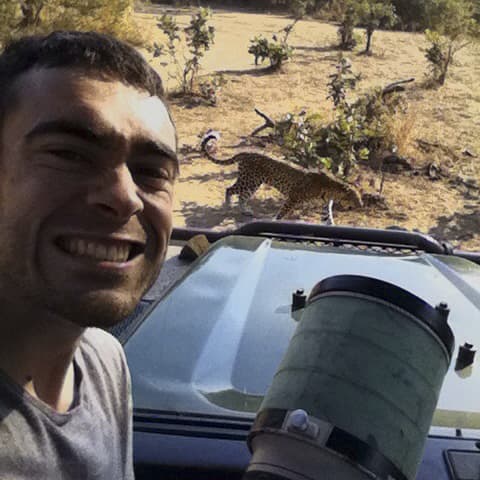
Quick wildlife photography tips and tricks
Here are some of our best wildlife photography tips, helping you recognise what makes a great shot, how to plan a successful trip as well as how to be respectful of the wildlife you are photographing.
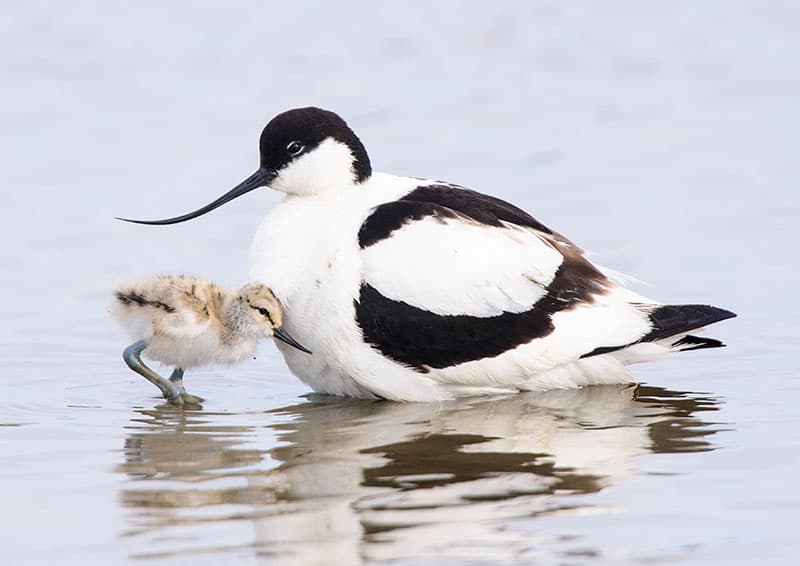
Credit: Oscar Dewhurst
Interactions
Young birds can be great wildlife photography subjects because there will be interactions such as feeding between them and their parents. However, it is really important to make sure that you don’t disturb them. If the birds start alarm calling then it would be wise to retreat, as your presence is clearly unsettling for them.
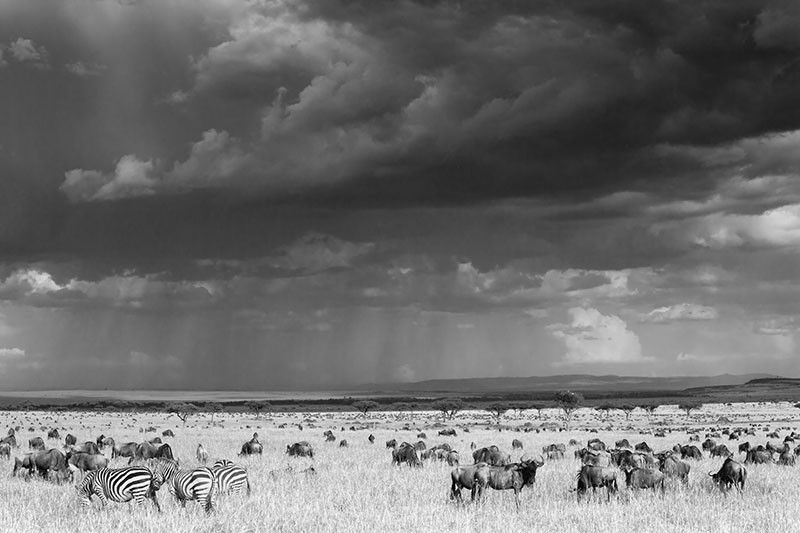
Credit: Ann and Steve Toon
Think ‘landscape’ for wildlife
Resist the temptation to shoot all your subjects up close on safari just because you can. We often like to pull back and do ‘animal-scapes’; showing off ‘small’ foreground subjects. This works especially well for Africa’s iconic big game set against the wonderful scenery or a simple backdrop of a vast sky.
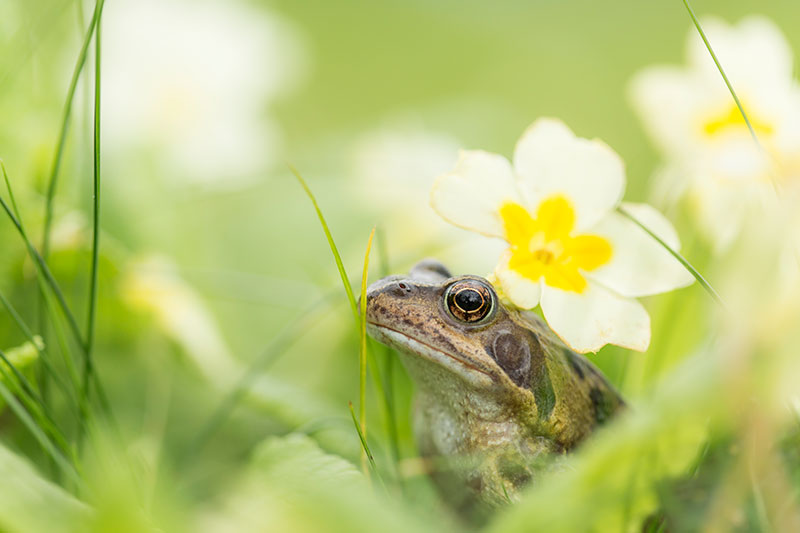
Credit: Victoria Hillman
Concentrate on composition
Amphibians and reptiles have beautiful and intense eyes so make them your focal point. Try composing with your subject off-centre for a different perspective, and photograph at eye level. To give your subject more context and create a more complex image that tells a story, look at incorporating the surrounding habitat.
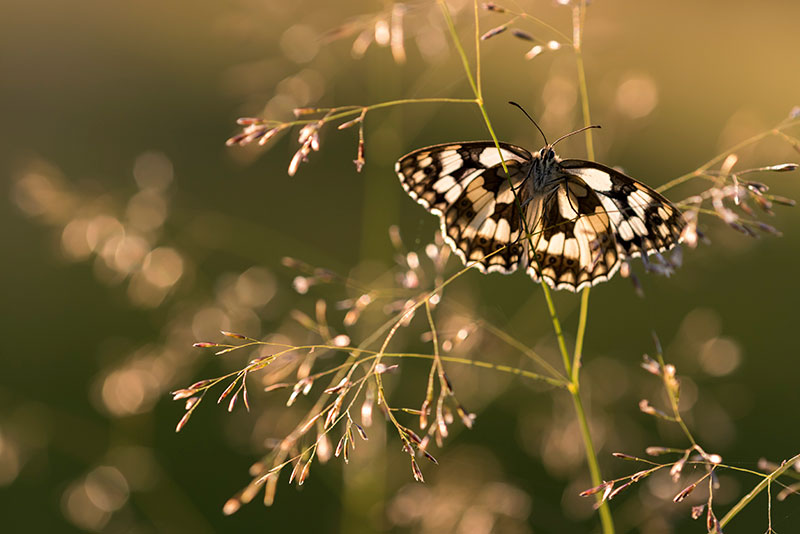
Backlighting particularly suits the translucency of butterflies. Credit: Ross Hoddinott
Use backlight
Backlighting really suits insects, as it tends to highlight their form, detail and intricacy. Low early-morning or late-evening light is perfect for shooting backlit subjects – the light’s quality is warmer and softer too. Position yourself carefully, so you sandwich your subject between the light and your camera. TTL metering can be fooled in tricky light, so check your histogram and apply positive exposure compensation if images are underexposed.
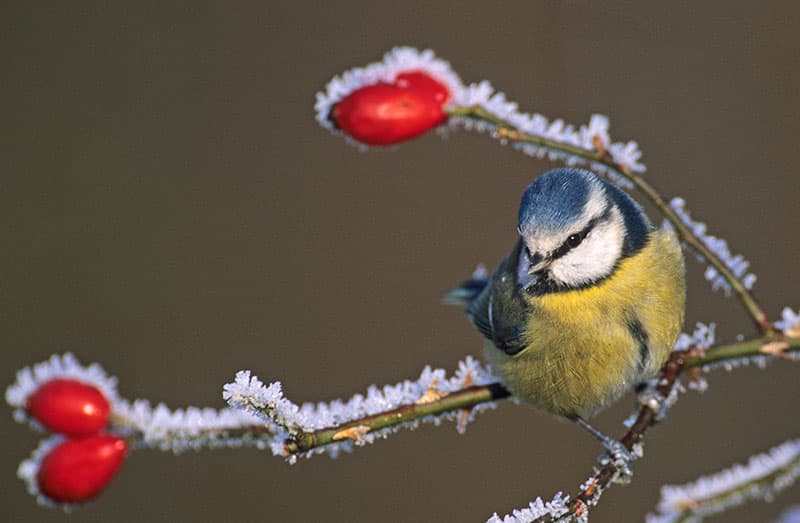
Spray foliage with water the night before a heavy frost is forecast. Credit: David Tipling
Plan for the weather
When photographing garden birds, keep an eye on the weather. If snow or frost is forecast ensure your perches or any other props are in place the night before. If you know a heavy frost is on the cards try spraying a perch, as well as any attractive berries or foliage, with water to emphasise the frosty look the next day.
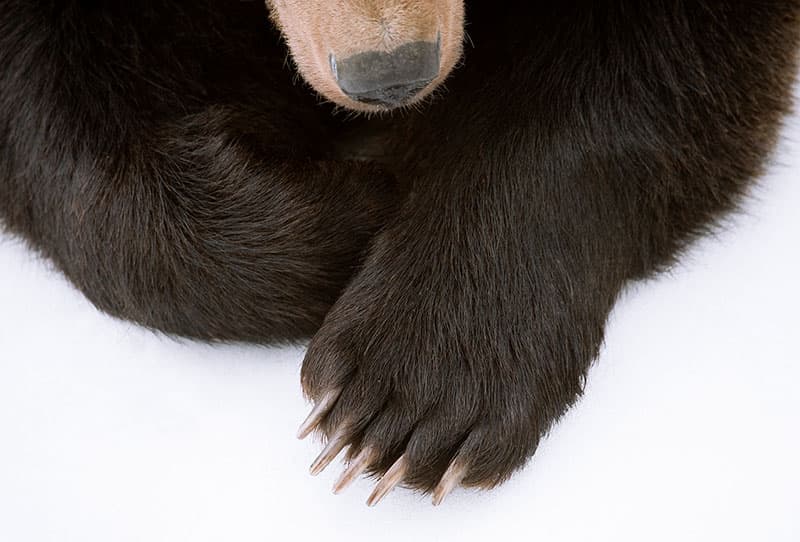
Credit: Chris Weston
Don’t take record shots
Before you press the shutter, ask yourself the question, ‘How would I caption this image?’ If the only answer you can come up with is the species name: a tiger, a bear, an eagle, etc – stop! Wait for a better shot. Avoid the standard record shot and try to say something more about your subject.
Don’t get starstruck
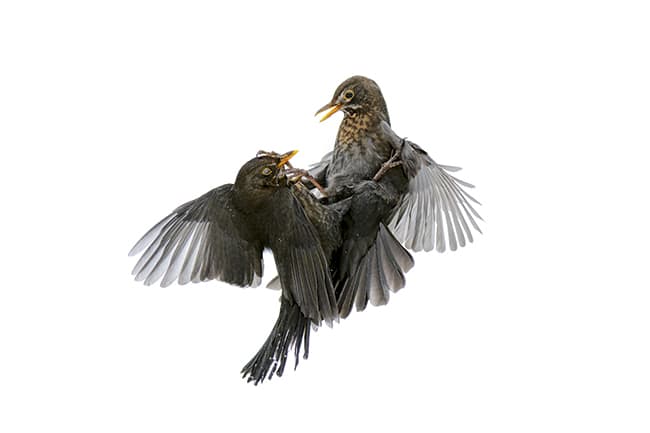
Less glamorous animals, such as these fighting blackbirds, shouldn’t be overlooked, as there can be a striking shot to be had. It can also help improve your skills for the future
It’s human nature to get a little starstruck now and again, as I did when I realised that I was sitting next to actress Keira Knightley in a restaurant! It is understandable that most wildlife photographers will have certain animals, such as lions, tigers and bears, high on their wish list of subjects. However, there are not many photographers who are fortunate enough to be able to spend a great amount of time working with such animals. For most, the opportunity to photograph them will probably be a once-in-a-lifetime experience.
While these star animals make great subjects to photograph, less glamorous animals should not be overlooked. Wildlife photography is the product of many factors, principally content and light. A star animal in the viewfinder does not guarantee a great image – a bad image of a lion is still a bad image. Many animals that are frequently overlooked are easy to access for little or no cost. For example, blackbirds are photographically an unremarkable little bird and are frequently ignored in preference to other, more colourful birds, such as kingfishers. A few winters ago, during a period of prolonged cold weather, food became scarce for many of the animals in the area where I live. This resulted in a larger than usual number of animals, including blackbirds, congregating at a feeding station near my home.
With the access road to the feeding station closed, the number of visitors putting food out was limited and as soon as any feed was put out for the birds, the blackbirds would descend on it. Desperate for food, fights would frequently break out between the blackbirds (see image above). This action, coupled with the wintry conditions, elevated these unremarkable birds to A-list status.
Look after your gear
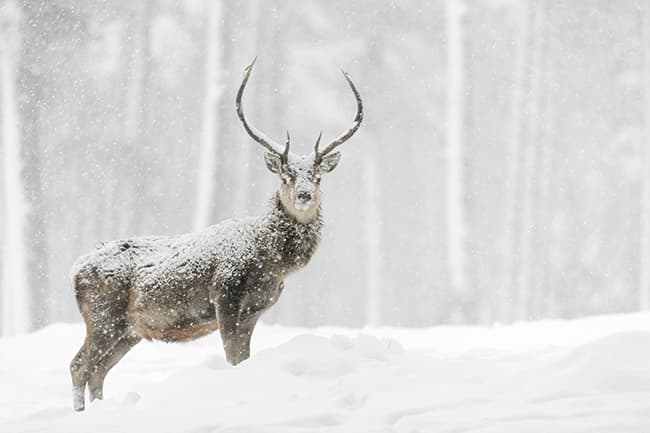
When shooting in harsh conditions, make sure you protect your gear. After each day’s photography, check and clean it, removing dust and dirt
Shooting in harsh environments places great demands on equipment. Having your camera kit fail for whatever reason can result in lost images from encounters that may never be repeated. Even if the problem occurs in the UK it will take days, if not weeks, for repairs to be completed. Simple precautions and maintenance can go a long way to prevent avoidable problems and allow you to keep shooting. A second backup body and doubling up on key focal lengths (teleconverters and a cropped-sensor/high-resolution DSLR on shorter telephoto lenses can replicate longer focal lengths) can be used if the primary camera and lens fail.
Carrying a DSLR with a super-telephoto lens attached to a heavy tripod on your shoulder for anything other than short distances, and especially off the beaten track, is not only uncomfortable, but also risks damaging your gear and injuring you. A small maintenance and repair kit with a multi-tool, Allen keys, gaffer tape and superglue will fix most minor issues.
Protect equipment when photographing in harsh environments, such as prolonged exposure to rain, snow, salt water and dust. Avoid changing lenses or teleconverters in these conditions. Doing so can result in expensive professional cleaning, at the very least. Water that penetrates and then freezes can jam camera and lens controls – and tripod legs. Rain and dust covers are a simple and relatively cheap way to protect equipment in these conditions, and some manufacturers make insulated versions for extreme cold weather. Plastic bags and old pillowcases are cheaper alternatives.
Be careful when taking equipment between areas of contrasting temperatures and humidity – acclimatise equipment inside a sealed camera or plastic bag to prevent condensation from developing inside camera gear.
Watch the background
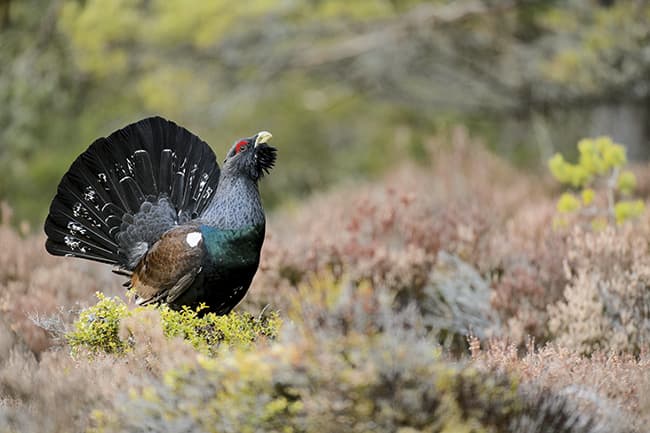
When composing an image, such as this shot of a capercaillie, avoid distracting elements and think about your positioning
The background in a wildlife image is just as important as the subject you focus on. The colour and brightness of the background and how much of it is in focus relative to the subject will affect the image. These factors can be used to create harmony or tension within an image, and can also be used to isolate or include an animal in its environment. The focal length of the lens used, aperture selected and the relative distances between the photographer, subject and background all affect how the background is rendered in a photograph.
Distracting elements can ruin an otherwise good image, as the eye will be drawn away from the subject. To avoid this, scan the viewfinder for any distracting elements when composing a shot, especially the edges. Pay particular attention to any spots of conflicting colour and any vegetation that appears to grow out of the subject’s head or any other part of its body!
When composing an image, where possible and safe to do so, do not simply choose the first spot you see and stand still. Try moving position relative to the subject and the background. Small changes in position can make critical improvements in the composition of an image and eliminate any distractions. When using a long focal length, by lowering your position relative to the subject, the in-focus area immediately behind the subject will be hidden and the background will instead be an area that is further away and out of focus. As well as changing position, try different focal lengths and apertures. When evaluating changes, use the depth of field preview function when looking though the viewfinder or make a test image and review it using the camera’s live-view function.
Work the light

A very bright day is perfect for photographing light-coloured subjects. Exposing for the feathers of this cygnet has naturally underexposed the water, providing a dark backdrop
Bright, warm light is what most people think of when you say ‘good light’. But the truth is, there is no such thing as bad light – bad light to obtain a specific style of photo, yes, but bad light in general, no. By learning what can be achieved with varying lighting conditions, you will improve your chances of coming away from a shoot without a completely empty memory card.
When the light is bright and warm, such as sunrise or sunset, try placing yourself between the sun and the subject for a nice evenly lit scene, or place the subject between you and the sun for some creative backlighting.
However, much more fun can be had when the light is not as bright. Overcast conditions are good for picking out feather and fur detail that would otherwise be lost in more contrasty conditions. This applies to both light and dark- coloured subjects, but be sure to keep an eye on your exposure, as the camera will want to brighten the scene to compensate for the lower light levels. Some underexposure may have to be dialled in manually to achieve the desired results. Very low light can also lend itself well to the use of flash, where you can intentionally underexposure the image, then use a flash gun to light up the subject. This gives a very dramatic feel to the final picture. If you don’t have a flashgun, try stopping down your aperture, lowering your ISO and reducing your shutter speed to capture motion in your image.
Add perspective
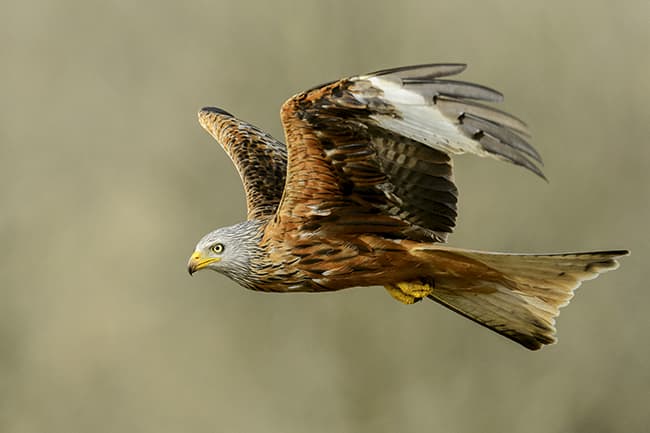
By sitting on a hillside, I was able to shoot across at eye level to this red kite, using the distant countryside fields and trees to provide a complementary background colour, rather than a typical blue sky
One of the best ways to draw a viewer into a photograph is to get your camera at eye-level with the subject. Of course, this may mean getting dirty, as a lot of animals are very small and most often found at ground level, but your images will take on an entirely new look if you do.
You can expand on this viewpoint by using close foreground and distant background elements to surround the subject in a completely out-of-focus palette of colour, or have the ground beneath the subject sharp and in focus, just leaving the background diffused.
But eye level is not all about getting down low to the ground – it’s simply a case of getting the right angle on a subject. Often with birds in flight, for example, the easiest image is obtained by looking straight up into the sky at them, but this can produce very unflattering images that lack impact. At best, you’ll see the underside of the bird set against a plain blue sky, and at worst, an underexposed silhouette against a plain white, cloudy sky.
Avoid the temptation to photograph birds until they are lower in the air, and all the better if you can get yourself up to a higher vantage point.
Be ethical
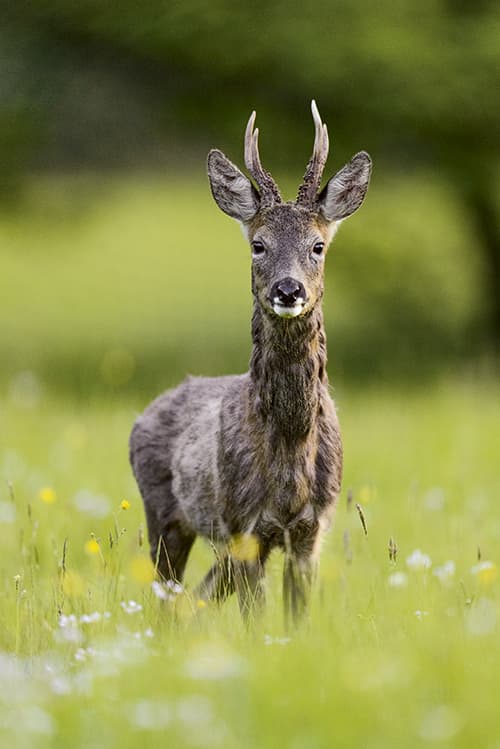
Roe deer are notoriously tricky to photograph. Most images, such as this one, show that the circle of fear has been breeched, even though a 600mm lens was used to keep a distance
Wildlife should always be respected. It goes without saying that if obtaining an image results in distress to the subject, the image should not be taken.
All animals have a ‘circle of fear’, and once you are within that, at the very least you will start to affect their natural behaviour and, at worst, disturb them to the point of making them move away. There are also a variety of animals in the UK protected by the Wildlife and Countryside Act 1981, which should be strictly adhered to, especially any subject falling under Schedule 1. If in any doubt, consult the Act to make sure capturing that prized image isn’t putting you on the wrong side of the law.
The biggest subject that divides opinion is that of baiting. To an extent, each photographer will have his or her own opinion. Should one animal be sacrificed to another in order to obtain an image? Most would say no, but then others will say it depends on the circumstances, the subject being photographed and the bait being used, and indeed many images out there will confirm those divisions in opinion.
Even baiting with food such as seeds and nuts is seen as unacceptable by some, as you are making an animal move to a place of your choosing that it otherwise may not have gone to, in order to photograph it. Again, opinion is divided, but it is important to ensure that any food put out is not bad for the animal and that you do not overfeed, making the animal reliant on your food source.
Observe the three Ps
I believe the key to success for a wildlife photographer is the three Ps: perseverance, patience and planning. Unless you get lucky, perseverance will always win out. The more you persevere, the luckier you’ll get. I tend to work on one subject at a time and maximise my time in the field. Most recently, I have been focusing on brown hares and each trip I make into hare habitat has the promise of producing new images.
To persevere means you will also have to be patient. You may need to wait long periods between bouts of action, but you must always be ready to react. If you take your eye off the ball you could miss the fleeting opportunity you were waiting for. For example, I have sat patiently, hour after hour, waiting for a dive from a fishing osprey in specifically placed hides. At times the action might be fast and furious, but then hours might go by without a visit. It is imperative to be always peering skywards through the hide, otherwise you might miss a dive that’s all over in seconds.
Perseverance and patience can be rewarded by planning. Researching your subject, working out the direction of light, the best time of day and locations will all save time and get you one step closer to capturing those dream images. By planning where to locate yourself for the best light and potential for action, you will help avoid leaving anything to chance.
Learn your subject’s behaviour
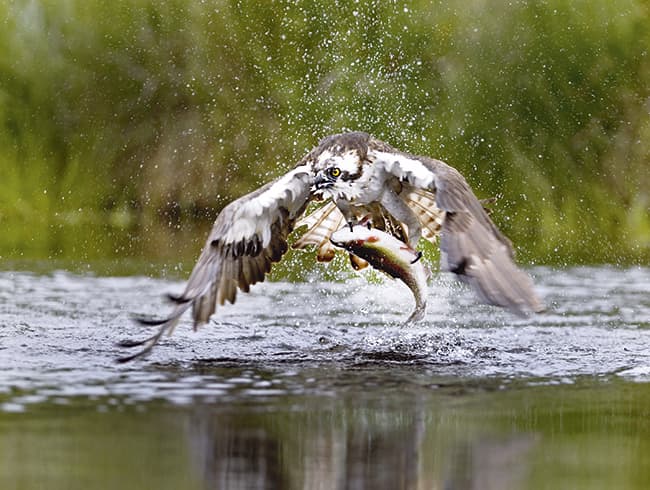
Many species exhibit signals that, once learned, are invaluable in capturing eye-catching shots. This shot of an osprey with a trout was taken in Scotland
Knowing what your subject may do at a given time will allow you to react and be in the right place at the right time. This is partly planning but there is no substitute for being out in the field, watching and learning.
I cut my teeth as a birdwatcher in the Medway Valley in Kent, and as a teenager I spent hours observing in the field. This has given me a feel for my subjects – an asset I believe has been invaluable in my career.
Read as much as you can, and if you have come to wildlife photography through photography then embrace being out in the field.
Animals give vital signs as to what they might do next. It’s clearly an asset if you know you are getting too close and in imminent danger of having your subject turn tail and run or fly. Equally, you will be prepared if a subject is about to do something worthy of a good shot. Ducks and swans provide vital clues when they are about to take off – they bob and shake their heads and face into the wind. Similarly, a bird of prey will normally ruffle its feathers before taking to the air.
Birds and mammals have what is commonly referred to as a ‘circle of fear’. If you cross a certain distance around them, they will look to flee or simply run or fly away. This can be the difference between a good portrait and a shot of a disappearing rear end. For example, a grazing deer may stop and look your way as you approach, and if it resumes feeding after a pause you might be able to move closer. However, if the deer moves position and keeps staring, chances are it is on the verge of fleeing. Being able to read these subtle nuances in behaviour comes with experience.
Never be afraid to experiment
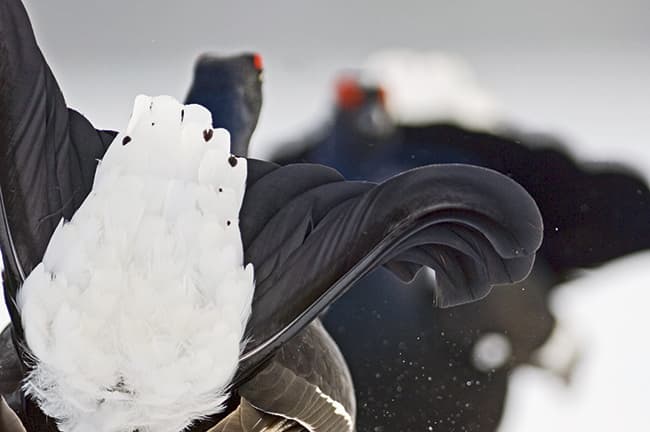
‘The judges won’t like that’. I have heard this said on numerous occasions referring to camera club competitions when I’ve suggested to a client on a workshop to shoot a subject in an abstract way. It seems that many photographers are afraid to experiment, but it’s often these images that remain in viewers’ minds, so never be afraid to try something different. It is tempting to go for the safe, well-lit, sharp portrait or super-sharp action image, but sometimes shooting motion-blur images or taking part of a subject may result in a more artistic picture.
A few years ago I sat in a hide photographing black grouse lekking (engaging in a mating display). As I peered out at all the males strutting their stuff, I was aware I was creating images that were similar to many I had made before. So I set out to shoot an abstract that would still tell the story of conflict but would be a more artistic interpretation. The result was an image that was Specially Commended in the Wildlife Photographer of the Year competition (left).
Be ready for the unexpected
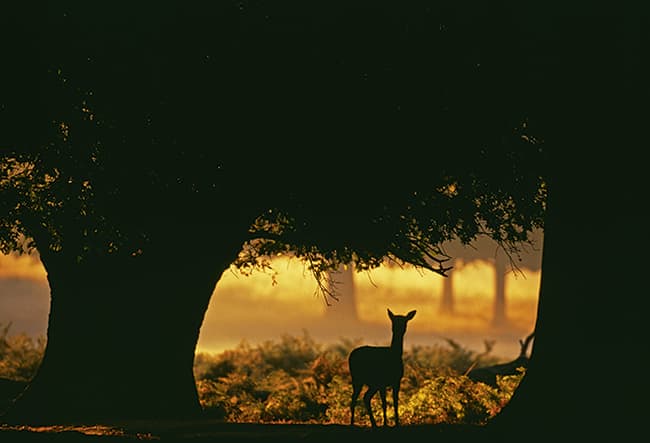
I am always ready for action whenever I am out in the field. My camera is switched on and the correct exposure dialled in so I am able to grab the camera and shoot within a second or two. You never know when an interesting bird or other subject might suddenly appear.
Wildlife photography subjects can sometimes do the most unexpected things, so it’s vital to be alert and ready. I have seen many other photographers, as well as myself, miss plenty of shots through doing too much reviewing of images on the back of the camera (chimping) when we should be alert for action.
I like nothing more than being out with my big lens mounted on its tripod over my shoulder ready for anything. I never know what I might end up photographing on any given day, but being ready may mean bagging the potential best shot of the day, as opposed to fumbling around and enduring an agonising missed opportunity.
If you’re ready to dive in but need to upgrade your kit, take a look at the best affordable lenses for wildlife photography.






